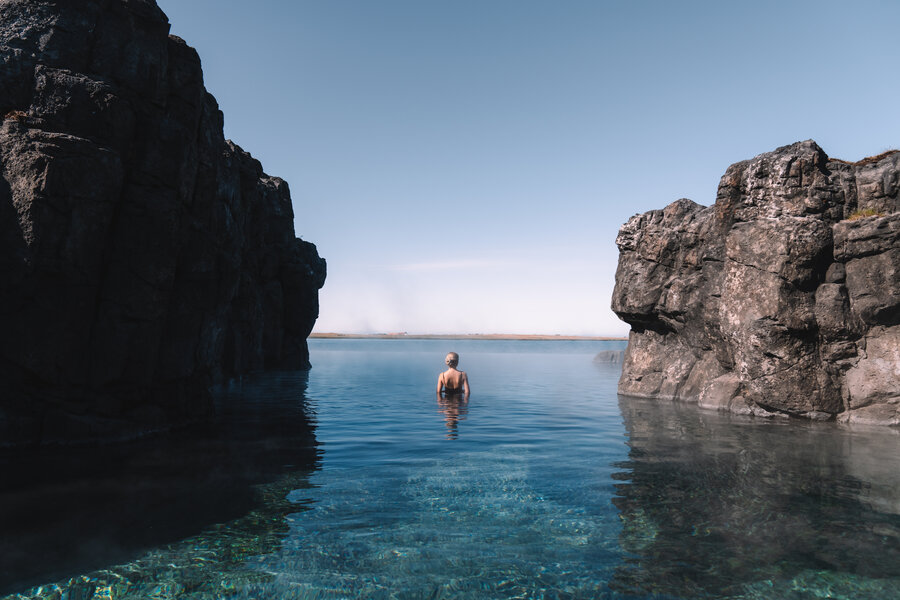Happening upon a turf house, or torfbæir as they’re called in Icelandic, is a fun surprise. The origins of the wooden house structures date all the way back to the first Norse settlements in 870. Some look like regular houses with grass growing on top (actually turf packed with volcanic ash), others are so embedded into the land that you don’t realize that they are actual homes until you see the wooden peak sticking out. Spot them without context and you might think they belong to elves, or, more appropriately to the country, Huldufólk, or Iceland’s hidden people.
If you want to actually luxuriate in one, you’re going to want to head to Sky Lagoon, the thermal baths that opened just outside of Reykjavík in 2021. Here you’ll not only get a slice of the country’s long bathing tradition, but also its cultural heritage.
This August they completed their own turf house as an extension of the spa. “We used an expert called Guðjón S. Kristinsson,” says Ragnheiður Harpa Haraldsdóttir, Sky Lagoon’s guest experience and marketing manager, who tells me to call her Heidi. “He’s one of the few people in Iceland that still knows the turf house trade.” Kristinsson sourced his turf from Iceland’s Reykjanes peninsula, where it contains so much volcanic ash its compact consistency is similar to concrete, providing ample insulation. And the authenticity extends to the builder himself. “He is exactly the way that you would think a person that builds turf houses would be,” says Heidi. Dressed in a wool shirt, with crazy hair, and speaking only very harsh Icelandic.”

 The turf house addition. | Courtesy of Sky Lagoon by Pursuit
The turf house addition. | Courtesy of Sky Lagoon by Pursuit
While the pandemic was a bad time for many new businesses to open, Sky Lagoon’s opening was almost fortuitous. People were itching for something new to experience, especially in the outdoors. “Sky Lagoon opened up and became the one new thing people could do,” says Heidi. “Everyone had just been in their sweats watching Netflix for years at that point probably, and when they realized that this was happening, it just became a phenomenon.”
It opened on the last day in April 2021, and that May was the most sunny month in the history of Mays, she tells me. At the same time a volcano started erupting, which you could see from the lagoon. “So you were literally in the lagoon watching a volcano erupt from a perfectly safe distance with sunny, nice weather outside, after you had just been locked up in your room,” she says. “So you can imagine the experience, and the emotions.”
It also helps that the lagoon is stunning. Sky Lagoon was created with the experience of place in mind. Volcanic boulders were brought in for the construction, creating an atmosphere both artificial and natural. There are grottos, a waterfall, and a swim-up bar. The water itself is crystal clear. But the focal point is the infinity pool, 230 feet along the length, which drops into the ocean, creating a seamless transition, making it feel like you’re soaking on the edge of the world. The view is sublime. From the ledge you can spot all manner of seabirds and if you stay long enough, maybe a seal.
The turf house is the home of the newly-unveiled Skjól wellness ritual—included with the price of admission— which incorporates seven wellness steps rooted in Icelandic heritage. Acclimate to the lagoon, then shock your system with a cold plunge. Then it’s on to the Ylur sauna where you’re encouraged to stay a while—it features the largest single-pane glass window in Iceland.
After the sauna it’s onto a cold mist, then a body scrub and the steam room. It’s capped off with an “elixir” made from the blue-black antioxidant-rich crowberries, which dot the lava fields. Then it’s back to the lagoon where, if you want to undo all of it, you can swim up to the bar and spend the rest of the time soaking with an Úlfrún IPA in hand.
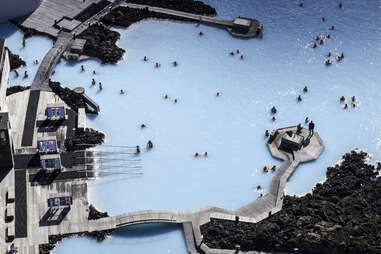
 An aerial view of the Blue Lagoon | John Moore/ Getty Images News
An aerial view of the Blue Lagoon | John Moore/ Getty Images News
The advent of artificial lagoons
Heidi likes to say that if your bathing suit gets dry while visiting Iceland, you’re not doing it right. Soaking in water is embedded in the culture. Even more, she says, Icelanders think of access to recreational water as basically a human right. “If there’s 150 people that live in a town, we will be talking about there needing to be a swimming pool,” she says. Children learn to splash around as early as 3 months old—there’s even a word for it, ungbarnasund, or infant swimming. And for adults, visiting a pool or bathing house is less about wellness than a way of being, originally stemming from keeping warm on winter nights, and learning to swim as part of fishing culture. “Bathing is like healing for the mind and the body, and it’s also something that became important to us when people were obviously getting all their food from fishing,” says Heidi. “Knowing how to swim was very important just for survival.”
In addition to over 100 swimming pools for its population of just over 350,000, Iceland has around 45 natural hot springs. This is the happy result of sitting on the Eurasian and North American tectonic plates, which meet at the Mid-Atlantic Ridge. Sky Lagoon’s structure is artificial, with volcanic boulders shipped in, but the water source taps into the island’s geothermal activity. The most famous artificial lagoon of them all, however, the Blue Lagoon, is the result of an accident.
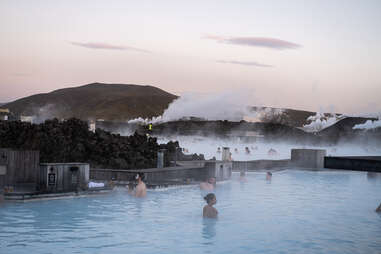
 Before Sky Lagoon, the vast majority of tourists visiting Iceland passed through the hot springs of the Blue Lagoon. | SOPA Images/LightRocket/Getty Imags
Before Sky Lagoon, the vast majority of tourists visiting Iceland passed through the hot springs of the Blue Lagoon. | SOPA Images/LightRocket/Getty Imags
The Blue Lagoon was first discovered in the 1970s, its hue the direct result of the nearby Svartsengi Geothermal Power Plant. The water from the plant was supposed to seep back through the lava into the volcanic aquifers, but the high concentration of slick silica made drainage difficult. Soon a body of water was created—one rich in silica, algae, and minerals, which quickly drew crowds who found not just a sense of calm, but relief from conditions like psoriasis.
In 1999 a formal spa facility opened at the location, the milky blue hue a striking contrast to the surrounding black lava fields. A little over a decade later National Geographic would call it one of the natural wonders of the world. Today there are two hotels on premises for you to spend your days in silica if the whim hits but, located near to Keflavik Airport it’s also a favorite place to soak on a layover. It’s also earned itself a spot on our list of the most trafficked tourist attractions. (We gave it an 8/10 in current vibes.)
As it’s a given that you’re going to soak as the Icleanders do on your vacation now the question is, which lagoon is best for you? Well, that’s where we come in.
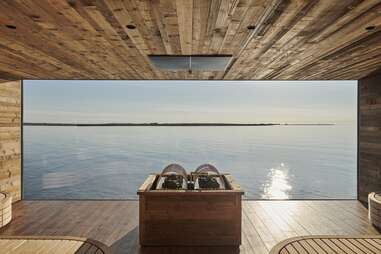
 See if you can spot a seal from the Sky Lagoon sauna. | Courtesy of Sky Lagoon by Pursuit
See if you can spot a seal from the Sky Lagoon sauna. | Courtesy of Sky Lagoon by Pursuit
Sky Lagoon vs. Blue Lagoon. Which one is right for me?
Cost
The entrance fee for Blue Lagoon ranges from $73 to $121. The lowest tier includes a drink and silica mud mask at the Mask Bar, with amenities added on from there.
The entrance fee for Sky Lagoon comes in two tiers: $76 and $98. Both include the Skjól ritual, while the higher price provides access to private changing rooms. For a more Icelandic experience, opt for the cheaper communal changing rooms. “The traditional way in Iceland is you just have the male and the female rooms, and everyone is kind of naked in front of each other, and no one really bothers,” says Heidi.
Size and facilities
At 94,000 square feet in size, the Blue Lagoon is massive. That means more people than Sky Lagoon, but also more room to spread out. Sky Lagoon is much smaller, but in our opinion, that creates a quieter, more intimate experience. This is also a personal preference, but we also prefer clear water to the milky hue. You never know what’s going on under there.
Age restrictions
Blue Lagoon allows children aged 2 to 13 free of charge. Children under 13 are not allowed in Sky Lagoon.
Accommodations
There are no overnight accommodations at Sky Lagoon. The Blue Lagoon has two hotels, the more exclusive Silica hotel, which has its own private blue lagoon, and 62-room Retreat. Both have unlimited access to lagoons.
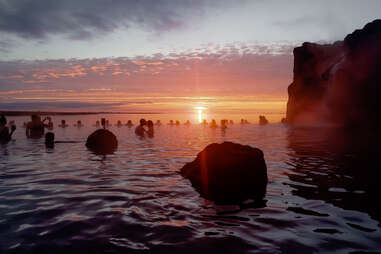
 Sky Lagoon at sunset. | Artur Debat/Moment/Getty Images
Sky Lagoon at sunset. | Artur Debat/Moment/Getty Images
Food and drink
Both the Blue Lagoon and Sky Lagoon have swim-up bars with a 3-drink maximum (a government restriction). And both have restaurants which you’ll have to leave the water of the lagoons to experience.
At the Blue Lagoon there’s the Spa Restaurant, where you can dine on light fare like salads and ceviche while enjoying a view of the lagoon. There’s also the Lava Restaurant, with heartier fare like lamb, beef, and cod.
Food at Sky Lagoon includes Sky Café for coffee and a quick bite, and Smakk Bar with local Icelandic platters including tastes like reindeer, pork and goose wild game pâté, and pickled herring. Food is all locally sourced. “Part of the charm of Iceland is not having Starbucks or McDonald’s and actually having local companies,” says Heidi. “So we took that quite seriously when choosing our vendors.”
Wellness offerings
Sky Lagoon includes the seven-step Skjol ritual. There’s also a waterfall, which you are encouraged to experience for a full-body sensory experience.
Silica can damage your hair, so you’re instructed to keep your head above water at the Blue Lagoon. However everyone gets at least one silica mask at the Mask Bar. In addition, you can opt for extra in-water massages and float therapies, as well as a massage at The Retreat spa.
